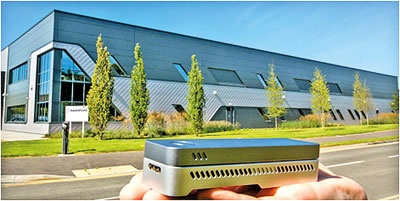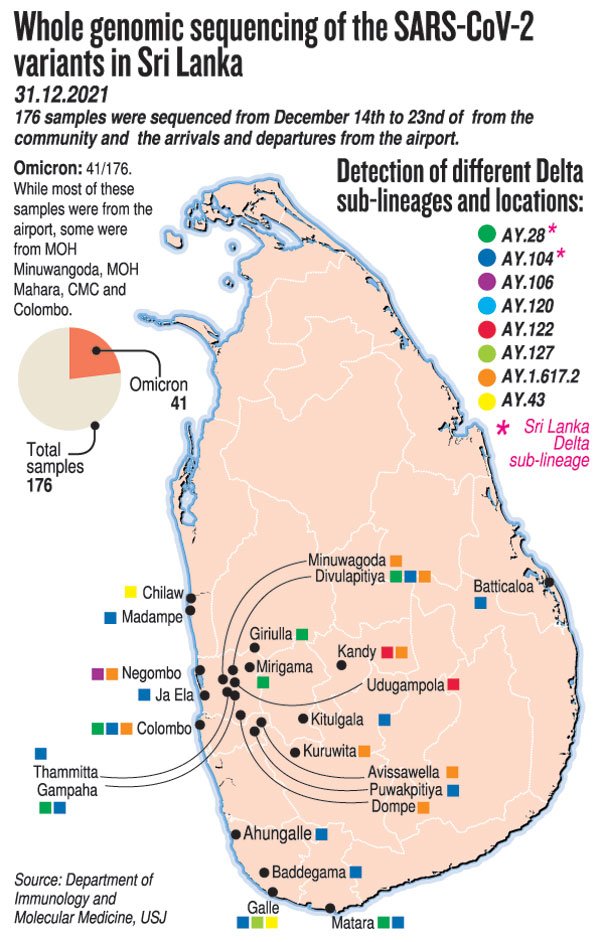News
Oxford trailblazer in SL to help set up more nanopore sequencing facilities

The manufacturing facility in Oxford in the shape of a MinION
The latest report is out – 41 of 176 samples sequenced from December 14 to 23, were infected by the Omicron variant of concern and the balance by Delta.
The samples sequenced by the laboratory of the Sri Jayewardenepura University’s Department of Immunology and Molecular Medicine under Prof. Neelika Malavige were from the community as well as from people arriving at and departing from the airport. (See graphic)
“We are able to carry out such sequencing to keep a pulse on what is happening in Sri Lanka due to a revolutionary technology,” says Prof. Malavige.
The technology she is referring to is – nanopore sequencing in which a trailblazer is Dr. Lakmal Jayasinghe, the Vice President of Research and Development (R&D) in Biological Sciences at Oxford Nanopore Technologies.
It is Dr. Jayasinghe’s team which has come up with the only portable real-time device – smilingly called by him as the ‘pocket size sequencer’ – known as MinION for the sequencing of DNA (deoxyribonucleic acid) and RNA (ribonucleic acid).
The manufacturing facility of his company which is based at the Oxford Science Park in the United Kingdom, also takes the shape of the sleek and small MinION, he says.
“The earlier sequencing technology in use in Sri Lanka is very expensive, while the ‘sample preparation time’ is longer and complicated,” explains Dr. Jayasinghe, when the Sunday Times meets him for an exclusive interview this week.
Mixing work and leisure, he is in Sri Lanka to help anyone who is interested in this easy technology, not only for the early detection of COVID-19 variants and other pathogens but also for a range of other uses.

NASA astronaut Kate Rubins uses nanopore sequencing technology in space for the first time in August 2016.
He has already supported the establishment of this technology for COVID sequencing at six laboratories in the country: the Sri Jayewardenepura University in June last year (2021); the Colombo University; the Kandy National Hospital; the Karapitiya Teaching Hospital; and two labs at the Medical Research Institute (MRI), Colombo.
“We trained the lab personnel with our Singapore customer service and technical support team and soon the labs were up and running. The Sri Jayewardenepura University, in fact, compared the previous method versus nanopore sequencing in a paper published in a scientific journal which found that nanopore is cheaper and easier to use,” he said.
This time around, he is here to assist the Peradeniya Medical Faculty lab to start COVID sequencing and a few other labs interested in agri-based applications.
Before delving into technicalities, Dr. Jayasinghe says that Oxford Nanopore has been listed by the Massachusetts Institute of Technology (MIT) Review as one of the “smartest” companies in the world. Its R&D programme has grown significantly over the years to become a $7.5 billion biotechnology company after a recent initial public offering (IPO). The company has satellite offices in Cambridge (UK); New York, Boston and San Francisco (United States of America); Singapore; Shanghai and Beijing (China); and a commercial presence that includes Japan, Germany, France and India.
Oxford Nanopore has more than 1,400 patents and patent applications across 200 patent families, with hundreds generated by internal R&D.
Next, it is a close look at what we are made of, from Dr. Jayasinghe as he says that DNA is the building block of life, whether human, animal, plant, bacterium or virus. DNA is made of four different types of sub-blocks or bases – A (adenine), C (cytosine), G (guanine) and T (thymine).
“Hundreds and thousands of these bases are arranged in a specific order to make a DNA strand. A piece of DNA with a specific sequence that defines a specific trait is called a gene,” he says, citing genes which are responsible for the colour of the eyes of a person; for breast cancer; or the spike protein of the coronavirus. 
He explains: “The complete set of genes in an organism which provides all the information the organism requires to function is the ‘genome’. The human genome is made of 3.2 billion bases; the rice genome of 430 million bases; and the E.coli genome of 4.6 million bases.
“In the genome of a virus such as COVID-19, there are about 30,000 bases. The order in which these bases are arranged within the DNA strand is the ‘sequence’ of the DNA. By knowing the DNA sequence of a gene or the genome, scientists can tell many things about the organism – What is it? What’s in it? What specific species is it? Is it changing? Is it healthy or diseased?
“With regard to COVID-19, the
sequence of the DNA of the virus will tell scientists which variant is spreading in a specific country or region, whether it is dangerous or more transmissible than other variants and whether it is responding to vaccines.”
It is this information which allows policy-makers to make ‘informed’ decisions on how to respond, without groping in the dark, reiterates Dr. Jayasinghe.
Armed with this valuable knowledge, it would be easy to decide whether a local lockdown is adequate or there should be a full scale-up to a country-wide lockdown. It is important knowledge on which areas to prioritise, when vaccine rollouts are taking place.
Looking into the past, he says that DNA sequencing is not new. Scientists have been using many different methods to sequence DNA over decades. It had taken 13 years and more than $3 billion for an international team of researchers to complete the sequencing and mapping of the first human genome. Since then, due to advances in DNA sequencing technologies, both the cost of sequencing and the time it takes to sequence a genome have come down significantly.
The latest set of technologies developed for DNA sequencing is generally called ‘next generation sequencing’ (NGS) methods, he says, pointing out that nanopore sequencing is one of the latest NGS technologies developed by Oxford Nanopore Technologies.
(See PLUS cover for
Dr. Lakmal Jayasinghe’s profile)
| Spread of Omicron in SL Here are the highlights of Friday’s media briefing at the Health Promotion Bureau (HPB): HPB Director Dr. Ranjith Batuwanthudawe – The latest sequencing done by the Sri Jayewardenepura University this week indicates that around 23% of the total number of samples is infected by Omicron. This indicates a spread of Omicron in the country. There are also several illnesses with fever-like symptoms these days. It is important for people to get the booster. There are queries on how to update the vaccination card. Contact the Medical Officer of Health (MOH) office in your area. When you get the new vaccination certificate, discard the previous one to prevent confusion. Consultant Physician Dr. Upul Dissanayake of the National Hospital of Sri Lanka (NHSL) – There are more dengue patients than COVID patients. If someone gets fever, it could be either disease. We see certain side-effects including headaches after the booster. If muscle pain, fatigue or headache become severe, it could be that the person who took the booster is actually having dengue, as these are common symptoms of dengue. Seek medical attention to check whether it is dengue, another illness or a side-effect of the booster. With the hope that there will not be a resurgence of another COVID-19 wave after 31st night, the plea is for people to enjoy the dawn of the New Year while maintaining social distancing. The Health Ministry’s Head of the Division of Disaster Preparedness and Response, Dr. Hemantha Herath – Public gatherings could lead to a spread of COVID-19. As such, it is vital to maintain social distancing and adhere to health guidelines. We have lifted restrictions to continue socio-economic activities and we urge the public to keep to preventive measures. To queries about what advice public and private sector offices should follow if having New Year celebrations – adhere to health guidelines, do not gather in small rooms and when consuming food, at which time the masks have to be removed, do so in an airy and spacious environment.
From across the world Fatigue, joint pain, cold and headaches are four common signs of Omicron that are different to those caused by the Delta variant, a United Kingdom-based study (the ZOE COVID Study) has found. Loss of smell and taste, meanwhile, which were common signs of Delta, were hardly seen in the case of Omicron. In other reports, a South African study had found that a single dose of the Johnson & Johnson COVID-19 vaccine topped up by a booster, cuts the risk of hospitalisation by up to 85% when Omicron was dominant. The study assessed the effectiveness of a booster shot of the vaccine (Ad26.COV2-S) on more than 69,000 healthcare workers six to nine months after primary vaccination. The findings of the real-world study are yet to be peer-reviewed. | |
The best way to say that you found the home of your dreams is by finding it on Hitad.lk. We have listings for apartments for sale or rent in Sri Lanka, no matter what locale you're looking for! Whether you live in Colombo, Galle, Kandy, Matara, Jaffna and more - we've got them all!

